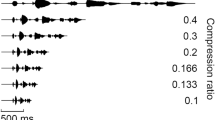Abstract
Temporal processing is critical to a wide variety of everyday listening tasks, including speech perception. Although the importance of signal to noise ratio (SNR) is well documented in speech perception experiments, it is less explored in temporal processing experiments. The present study examined the effect of SNR on temporal processing abilities using Gap Detection Threshold (GDT) in children and adults. The study included a total of 45 subjects, where in, 25 children (Group-1) and 20 adults (Group-2) with pure-tone thresholds ranging from 0 to 25 dB HL at frequency range 250–8000 Hz. The GDT was measured at presentation level 50 dBSL. All the measurements were performed in 5 different conditions: ‘Quiet’, ‘ + 10 dB SNR’, ‘ + 5 dB SNR’, ‘ + 0 dB SNR’ and ‘ − 5 dB SNR’. Gap Detection Thresholds are significantly higher from + 10 to − 5 dB SNR when compared to quiet condition in young-adults and all sub-groups of children, whereas at + 10 dB SNR, thresholds were not significantly different from quiet condition in young-adults and all sub-groups of children except for sub-group A of children, and were significantly different for all the five conditions. It was revealed that, as the signal to noise ratio (SNR) was decreased from + 10 dB SNR to 0 dB SNR there was a significant increase in Gap Detection Thresholds. There was a significant increase in Gap Detection Thresholds from + 10 dB SNR to − 5 dB SNR in both children and adults. The results also suggest that the performance on temporal processing task in the presence of background noise achieves young-adult like pattern by the age of 10–11 years. Background noise affect temporal processing in both children and young-adults. Background noise impairs temporal processing in children more than the adults, which could be because of poor temporal resolving abilities in children.





Similar content being viewed by others
References
American National Standards Institute (ANSI) (1999) Maximum permissible ambient noise levels for audiometric test rooms. (ANSI S3.1–1999). New York: ANSI
American Speech-Language-Hearing Association (1996) Central auditory processing: current status of research and implications for clinical practice. Am J Audiol 5:41–54
Cooper JC, Cuts BP (1971) Speech discrimination in noise. J Speech Hear Res 14:332–337
Davis SM, McCroskey RL (1980) Auditory fusion in children. Child Dev 51:75–80
Duquesnoy AJ (1983) The intelligibility of sentences in quiet and in noise in aged listeners. J Acoust Soc Am 74(4):1136–1144
Grouse JH, Hall JH, Gibbs C (1993) Temporal analysis in children. J Speech Hear Res 36:351–356
Hawkins JE, Stevens SS (1950) The masking of pure tones and of speech by white noise. J Acoust Soc Am 22(1):6–13
Irwin RJ, Ball AKR, Kay K, Stillman JA, Rosser J (1985) The development of auditory temporal acuity in children. Child Dev 56:614–620
Jensen K, Neff DL (1993) Development of basic auditory dysfunction in preschool children. Psychol Sci 4:104–107
Mills JH (1975) Noise and children: A review of literature. Journal of Acoustical Soceity of America 58(4):767–779
Morrongiello BA, Kulipg JW, Clifton RK (1984) Developmental changes in auditory temporal perception. Child Dev 55:461–471
Phillips DP (2002) Central auditory system and central auditory processing disorders: some conceptual issues. Semin Hear 23:251–261
Plomp R, Mimpen AM (1979) Speech-reception threshold for sentences as a function of age and noise level. J Acoust Soc Am 66(5):1333–1342
Shailer MJ, Moore BCJ (1983) Detection of temporal gaps in band limited noise: Effects of variation in Bandwidth and signal to ratio. J Acoust Soc Am 77(2):635–639
Shivaprakash S (2003) Gap detection test–development of norms. unpublished independent project. University of Mysore, Mysore
Snell KB (1997) Age related changes in temporal gap detection. J Acoust Soc Am 101(4):2214–2220
Stuart A (2005) Development of auditory temporal resolution in school-age children revealed by word recognition in continuous and interrupted noise. Ear Hear 26(1):78–88
Wagener KC, Brand T (2005) Speech intelligibility in noise for listeners with normal hearing and hearing impairment: influence of measurement procedure and masking parameters. Int J Audiol 44(3):144–156
Wilson RH, Strouse A (1999) Word recognition in multitalker babble. American speech and hearing association convention, San Francisco (CA)
Author information
Authors and Affiliations
Corresponding author
Additional information
Publisher's Note
Springer Nature remains neutral with regard to jurisdictional claims in published maps and institutional affiliations.
Rights and permissions
About this article
Cite this article
Saxena, U., Damarla, V., Kumar, S.B.R. et al. Evaluation of Temporal Processing Abilities in Competing Noise. Indian J Otolaryngol Head Neck Surg 74 (Suppl 3), 3604–3609 (2022). https://doi.org/10.1007/s12070-020-02098-z
Received:
Accepted:
Published:
Issue Date:
DOI: https://doi.org/10.1007/s12070-020-02098-z




